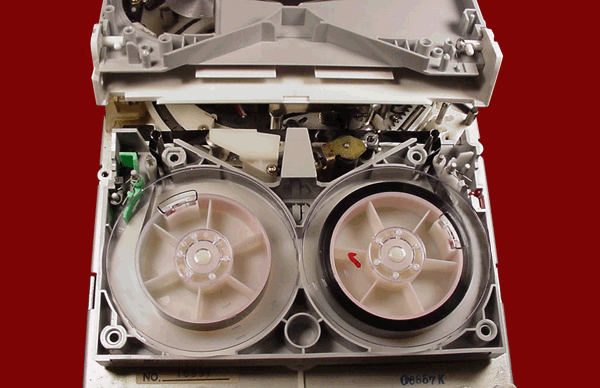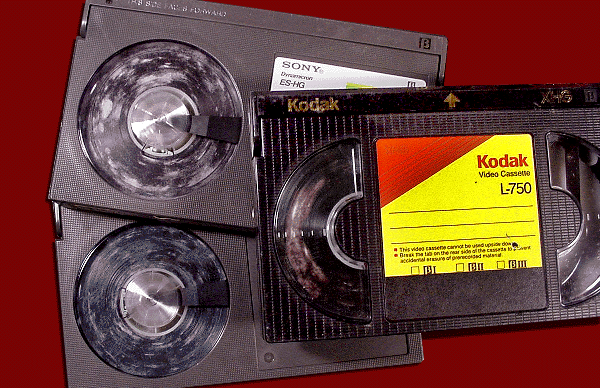You put a lot of time into recording those Beta cassettes. So what is the best way to insure that they will be watchable for years to come? Here are the steps to pampering those cassettes and saving those precious memories.
- Leave the cassettes in their protective sleeve because it closes off the tape entryway. This is the only opening to the interior and it is imperative that it be kept free from dust, pollen and other airborne impurities. Putting the cassette inside the sleeve seals off the entryway and keeps it secure. It also helps reduce static electricity which can attract tiny particles suspended in the air. If a sleeve is not available then place the cassette in an appropriate sized plastic bag and seal it off. Airborne debris is the nemesis of a clear, clean picture. (See a photo of the inside of a typical Beta cassette below.)
- Label your cassettes. It will help keep your sanity if you can easily identify what is recorded on them. It will save time and it will make sorting easier. The best place to do this is on the spine label (the one that runs the length of the cassette). The best way to mark these is with a soft graphite pencil. This makes removal easier using a Pink Pearl eraser. This way you can make corrections or move lettering around if needed. Use as few a words as necessary for quick identification. Use the cassette top label for additional notations like the date, speed, type or recording. etc.
- If possible store cassettes with the tail out (wound all the way to the end). This is best after the machine has run the tape to the end during playback. This method insures that it has the proper tension. Not too loose or not too tight, uniform and smooth. Warning, rewinding cassettes in a pop-n-stop winder can cause the tape on the spool to shift and deform. (Below is a photo winding damage.)
- If you plan to store cassettes in bulk put them in a storage bin or plastic container like the ones used for clothing or perishables. If it can be sealed so much the better. Reserve this carton only for video cassettes. Storing them with other items could cause contamination, mold or spoilage. Label the container so it can easily identified.
- The cassettes can be packaged either flat of vertical. The Beta cassette design is super sturdy and it takes a lot of pressure to deform or crack it. If there is a preferred way to store it would be vertical with the loaded take-up reel at the bottom. Just don't stack them in a manner that puts excess weight on the shell If the cassette should become deformed it could be mechanically inoperable.
- Store the cassettes (or container) in a location that maintains a temperature between 60 and 80 degrees Fahrenheit. Too hot and the tape will expand, loosen and become distorted. Too cold and the tape will shrink, tighten, crack or become warped. Excess heat or cold can also cause the recording media to break down and flake off. (Below is a photo of temperature damage.)
- Store the cassettes (or container) in a location that maintains a humidity between 40% and 60%. Too dry and the tape can become brittle and subject to breaking. Too humid and it can get moldy and become unwatchable. If necessary place the cassettes in individual zip lock bags. This will provide extra protection from humidity. (Below is a photo several Beta cassette with mold inside.)
- Store the cassettes in an area that does not have a strong magnetic field nearby. Do not bring cassettes in close contact with a magnet. Video tape is designed to store a fairly weak magnetic signal. Getting it too near magnetism will erase or scramble the signal and make the tape unwatchable.
- It has been recommended (by some) that you carefully rewind and play the cassette(s) every few years. This readjusts the tape by keeping it wound with the correct amount of tension. It also allows air to trap itself again between the tape layers. This air cushion conditions the tape and insures that it is smoothly wound back on to the take-up reel inside the cassette.
- If possible back up your cassettes to avoid disaster. This gives you another copy. It can be to another medium like a hard drive or DVD. But like all storage methods these too are subject to loss, degradation and damage. Keep your original machine. It matches your tapes and is the device most likely to play them correctly. Magnetic tape has been around a long time and will last for years if properly cared for. Using good judgement will allow you to hang on to these properties for as long as humanly possible.
In closing let me pass this along. Of all the steps listed above the ones that probably have the biggest impact are temperature and humidity. Because video tape is a thin base film it is very sensitive to its environment. If you feel that your tapes have become compromised, all is not lost. Questionable recordings can sometimes be recovered by employing special procedures. One way to do this is to have your playback machine adjusted so that it will track a troublesome tape(s). This is somewhat drastic because it will affect change the tracking center permanently. There are also professional services that specialize in resurrecting damaged recordings. This process relies on technical equipment that can strip away offending parts of the video signal errors. These can ignore parts of the video signal and generate a false sync pulse or generate a new time base1 so that copies can be made. The content is stored to a different media and is watchable again. But you can bet that as the interest continues to grow the field of video reclamation will find more ways to bring old memories back. So don't give up, they probably can be saved. But expect it to cost you in time and/or money.
Here is what the inside of a Beta cassettes looks like when it is sitting inside the machine. This is before it is threaded into the tape path (the cassette top is lifted up and out of the way for viewing). Moving components that pull the tape out are parked in the loading pocket. It is located in the center of the photograph:
Here is what the spools inside a Beta cassettes looks like when the tape has been subjected to extremes of hot or cold. A violent stop at the end of winding can also cause this type of bunching:
Here is what moldy cassettes look like. Never put tapes like these in your precious Betamax:
1Time base correction is a technique used to reduce or eliminate errors caused by mechanical instability present in analog recordings on mechanical media. Without time base correction, a signal from a videotape recorder (VTR) or videocassette recorder (VCR) cannot be mixed with other, more time stable devices found in television studios and post-production facilities. Most broadcast quality VCRs have simple time base correctors built in though external time base correctors (TBCs) are often used. Some high end domestic analog video recorders and camcorders also include a TBC circuit, which typically can be switched off if required. Time base correction counteracts errors by buffering the video signal as it comes off the videotape at an unsteady rate, and releasing it at a steady rate. TBCs also allow a variable delay in the video stream. By adjusting the rate and delay using a waveform monitor and a vectorscope, the corrected signal can now match the timing of the other devices in the system. If all of the devices in a system are adjusted so their signals meet the video switcher at the same time and at the same rate, the signals can be mixed. A single master clock or "sync generator" provides the reference for all of the devices internal clocks.
|


